



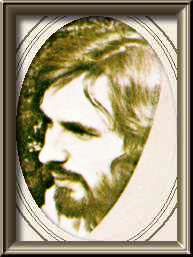
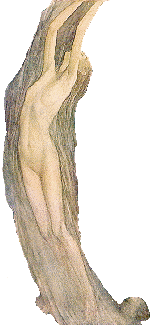
 Alan Lee was born in 1947, (which makes him
a year younger than I am), in Middlesex, England. He studied at
the Ealing School of Art. He moved to Dartmoor in 1975. When Faeries
(image at left), which he illustrated with studio mate Brian Froud,
burst upon the scene in 1978, the dust wrapper notes that he had
"painted dozens of cover illustrations for imaginative fiction."
Most of his work prior to 1978 had been in publishing and commercial
art, not illustration. One indication of this is that I have only
been able to scour up two instances of his work from 1976 and
nothing earlier. It would be wonderful if someone knew the whereabouts
of the "dozens" of covers he did. I would love to hear
about them.
Alan Lee was born in 1947, (which makes him
a year younger than I am), in Middlesex, England. He studied at
the Ealing School of Art. He moved to Dartmoor in 1975. When Faeries
(image at left), which he illustrated with studio mate Brian Froud,
burst upon the scene in 1978, the dust wrapper notes that he had
"painted dozens of cover illustrations for imaginative fiction."
Most of his work prior to 1978 had been in publishing and commercial
art, not illustration. One indication of this is that I have only
been able to scour up two instances of his work from 1976 and
nothing earlier. It would be wonderful if someone knew the whereabouts
of the "dozens" of covers he did. I would love to hear
about them.
And I recently did! At right is the dustjacket illustration for a 1971 edtion of The Importance of Being Earnest. It's the earliest Alan Lee I've seen.
At a time when reverence for the illustrators of the Golden Age was uncommon, Lee crafted his style from a mixture of 50 and 60 year old influences. The works of Arthur Rackham and Charles Robinson played important roles in his studies and direction. Like these artists, Lee's medium was watercolor in a classically romantic style. Lee's lack of a black bounding line for his images puts some in mind of Edmund Dulac, another artist from the turn-of-the-century with whom he is compared.
 In
the 1976 David Larkin book, Once Upon a Time - Some Contemporary
Illustrators of Fantasy, (image at right), it's very evident
just how far out of step with the times he was. With the exception
of Froud, none of the 14 other artists in the book grew out of
the Romantic tradition of children's illustration that editor
Larkin compares them to on the back of the book. But then, Larkin
chose Lee and Froud for the cover positions, so we know where
his sympathies lay. Plus Larkin had been reviving interest in
those earlier masters with a series of books devoted to them,
starting with The Fantastic Kingdom in 1974.
In
the 1976 David Larkin book, Once Upon a Time - Some Contemporary
Illustrators of Fantasy, (image at right), it's very evident
just how far out of step with the times he was. With the exception
of Froud, none of the 14 other artists in the book grew out of
the Romantic tradition of children's illustration that editor
Larkin compares them to on the back of the book. But then, Larkin
chose Lee and Froud for the cover positions, so we know where
his sympathies lay. Plus Larkin had been reviving interest in
those earlier masters with a series of books devoted to them,
starting with The Fantastic Kingdom in 1974.
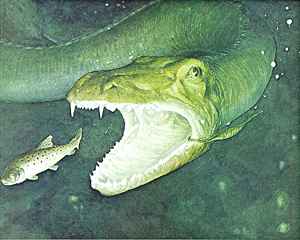
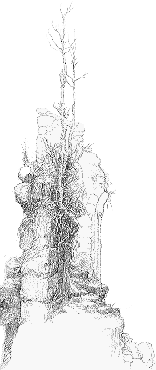 The second example of his pre-Faeries work that I've
been able to find is the 1976 The Golden Book of the Mysterious.
This 144-page American title features Lee's watercolors on almost
every page. With the whole realm of the unknown as subject matter,
Lee was free to exercise his imagination. The results are stunning
paintings (see above) that feature subject matter, like space
shuttles, airplanes and aliens, that he never tackled again.
The second example of his pre-Faeries work that I've
been able to find is the 1976 The Golden Book of the Mysterious.
This 144-page American title features Lee's watercolors on almost
every page. With the whole realm of the unknown as subject matter,
Lee was free to exercise his imagination. The results are stunning
paintings (see above) that feature subject matter, like space
shuttles, airplanes and aliens, that he never tackled again.
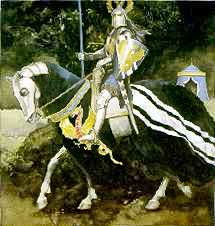 All of the five Alan
Lee images in Once Upon a Time are labeled as "unpublished"
and the first one is from "The Mabinogion" - a collection
of Celtic myth. The success of Faeries allowed him to devote
several years to bringing this passion to life. In 1982, Dragon's
Dream published The Mabinogion, 224 pages loaded with lovingly
drawn visions of knights and kings, maidens and magic, dragons
and ogres. The full page plates have illustrated, painted borders
and the chapter heads are precise pen and ink drawings. This is
still my favorite of his books.
All of the five Alan
Lee images in Once Upon a Time are labeled as "unpublished"
and the first one is from "The Mabinogion" - a collection
of Celtic myth. The success of Faeries allowed him to devote
several years to bringing this passion to life. In 1982, Dragon's
Dream published The Mabinogion, 224 pages loaded with lovingly
drawn visions of knights and kings, maidens and magic, dragons
and ogres. The full page plates have illustrated, painted borders
and the chapter heads are precise pen and ink drawings. This is
still my favorite of his books.
The Arthurian motif of The Mabinogion was followed in 1984 by Castles. This established, if not the trend, at least his penchant for the British and European romance and fairy tale. It also showcased the hitherto seldom-seen world of his pencil art. See the example above right. It exemplified the totality of his art and his choices of when to use the medium paid off handsomely in emotional dividends. The book was designed and edited by David Larkin.
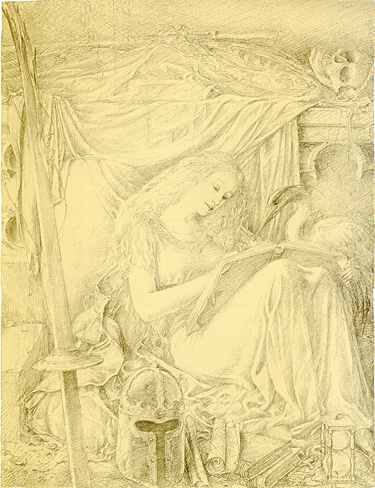
While the pencil drawings in Castles were new to most of his fans, a small subset of 750 had studied them in 1983 in a large, lavish portfolio entitled, The Drawings of Alan Lee. Eight drawings were presented in an impressive boxed format. They were reproduced directly from the originals via the best techniques available. The Inheritance, above, is one of them. Signed and numbered, the portfolio is very uncommon today.
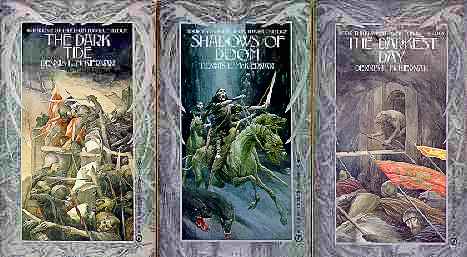
Also in 1984, Lee broke into the American paperback market with the covers for Dennis L. McKiernan's Iron Tower trilogy (above) published by Signet. Two Ursula K. Le Guin titles, The Eye of the Heron and Orsinian Tales were also in 1984 from Bantam. The only other example I've found is Brokedown Palace in 1986,
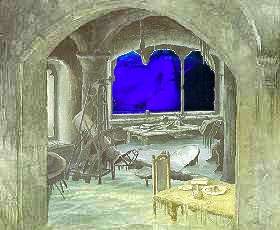
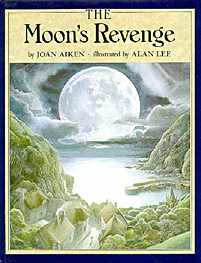 The gigantic
blue face in the window at left is actually a hologram. In The
Mirrorstone (1986), Lee teamed with high-tech real-life wizard,
Richard Seymour, to bring this Michael Palin story to life. It
was the first book to be published incorporating holographic images
into the story. Mirrors, windows, puddles and crystal balls all
featured more than any prior book had been able to offer - true
three dimensional depth.
The gigantic
blue face in the window at left is actually a hologram. In The
Mirrorstone (1986), Lee teamed with high-tech real-life wizard,
Richard Seymour, to bring this Michael Palin story to life. It
was the first book to be published incorporating holographic images
into the story. Mirrors, windows, puddles and crystal balls all
featured more than any prior book had been able to offer - true
three dimensional depth.
The Moon's Revenge in 1987 was followed by Merlin Dreams in 1988. Like Castles, this featured pencil drawings amongst the watercolors and was lavishly and lovingly illustrated. The sleeping girl below is just one of dozens of small illustrations in the Merlin Dreams text.

 About
this time, Alan became the main illustrator for the quintessential
British fantasy author, J.R.R. Tolkien. When The Lord of the
Rings was reissued in a three volume set in 1987
About
this time, Alan became the main illustrator for the quintessential
British fantasy author, J.R.R. Tolkien. When The Lord of the
Rings was reissued in a three volume set in 1987![]() ,
the dust jackets were by Lee. As the multi-volume The History
of Middle-Earth was released, Lee was the choice for cover
artist at least on volumes VI-IX, though the images all found
their way into his next masterpiece.
,
the dust jackets were by Lee. As the multi-volume The History
of Middle-Earth was released, Lee was the choice for cover
artist at least on volumes VI-IX, though the images all found
their way into his next masterpiece.
To celebrate the 100th anniversary of the birth of Tolkien, a new 1200 page edition of The Lord of the Rings was planned. The illustrator of choice was Alan Lee. With 50 color plates (one sample at left), featuring some of his most precise and beautiful work to date, the book was a stunning artistic and commercial success. He did all new illustrations for the 1993 J.R.R. Tolkien calendar and a new edition of The Hobbit in 1997. He was so connected to the material that when David Day wrote a book on the significance of the ring in myth and literature, he titled the book Tolkien's Ring and got Alan Lee to illustrate it. (see below for his rendition of the Rhine Maidens.)
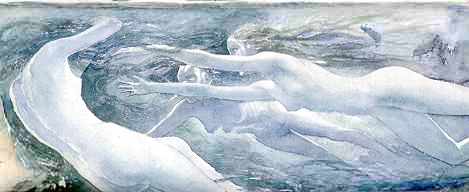
In addition to tackling Tolkien, he also did profusely illustrated versions of two much older classics: The Iliad (Black Ships Before Troy - 1993) and the Odyssey (The Wanderings of Odysseus - 1995), both adapted by Rosemary Sutcliff. Lee was the recipient of the Kate Greenaway award in 1993 for Black Ships. The award is given annually for the most distinguished work in the illustration of children's books published in the United Kingdom.
If that's not sufficient, he works as a set designer on films (Legend - 1985, Erik the Viking - 1989, Merlin - 1998) and will feature prominently in the design of the upcoming adaptations of Tolkien that are in the works. Between films, he still lives and works in the same small village on the edge of Dartmoor near Devon where he and Brian Froud retired to create Faeries. Brian and Wendy Froud still live there, too, along with other artists and writers of myth and magic. Perhaps there's something in the water...
It is possible that the 1987 three-volume slip-cased edition did NOT have dust jackets and slipcase illustrations by Lee. My set is clearly labeled "second edition" and the only 1987 copyright notice in the book refers to the new introduction which makes no mention of Lee. For all I really know, the 1987 set may not have been boxed and they used images from the 1991 Centenial edition to produce this boxed "second edition" somewhat later. Can anyone clarify this?
 To learn more about Alan Lee, see:
To learn more about Alan Lee, see:| Once Upon a Time - Some Contemporary Illustrators of Fantasy | David Larkin, 1976 Peacock/Bantam |
| The Vadeboncoeur Collection of Knowledge | Jim Vadeboncoeur, Jr. 2000 |
|
Illustrations are copyright by their respective owners. This page written, designed & © 2000 by Jim Vadeboncoeur, Jr. Updated 2011. |
